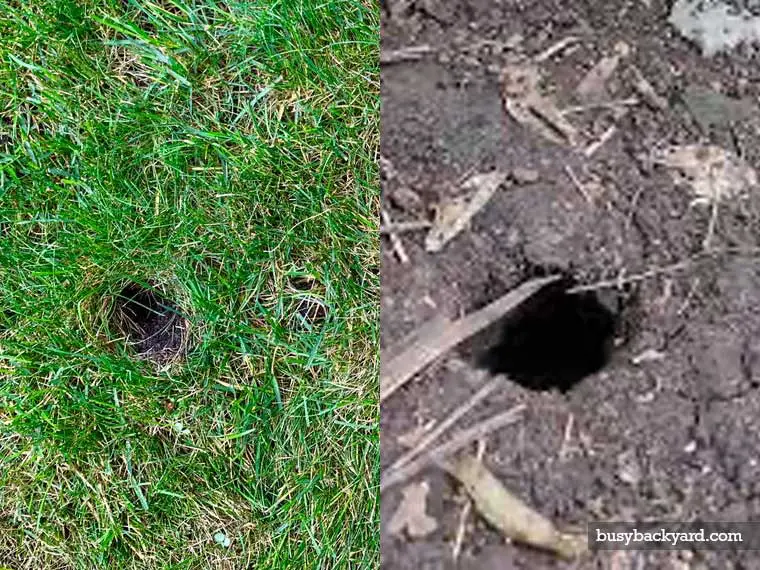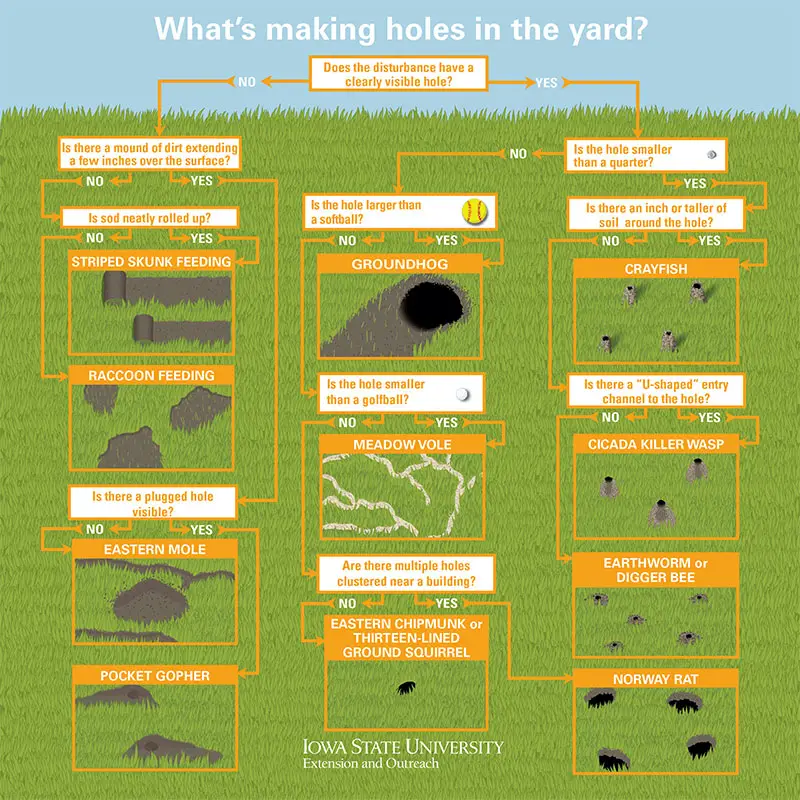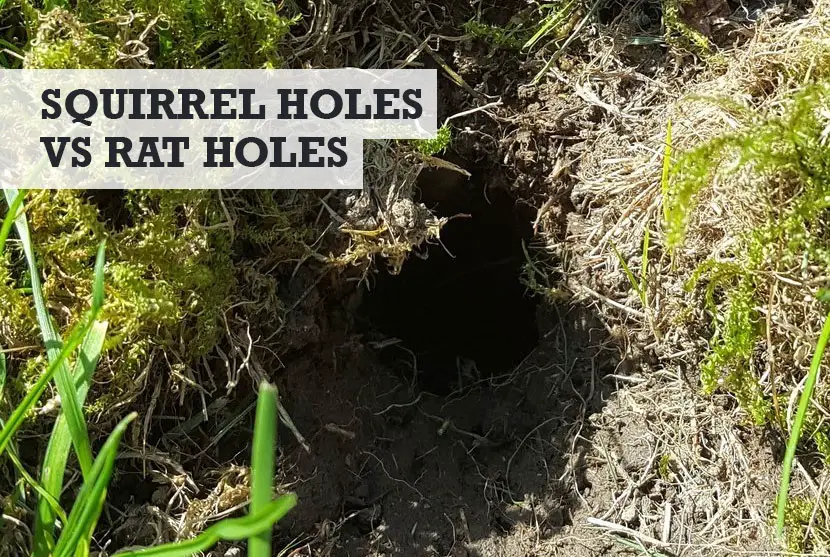Our backyard is bordered by woods. It means we get to see a lot of wildlife. But it also means we are host to certain critters that can cause damage. The ones which get me the craziest are squirrels and rats.
I’ve had my battles with both and have seen the damage they can do to lawns and garden areas, in particular the holes that both will dig. I can debate the squirrel holes vs rat holes question all day long and can tell you what I prefer and how to deal with them.
Firstly, I want to explain the differences between squirrel holes and rat holes. It’s relatively easy to tell the difference as rats and squirrels dig holes for very different reasons.
The difference between squirrel holes and rat holes
When a squirrel digs a hole in your yard or garden lawn, it’s not digging to create a tunnel or place to burrow and get into. Squirrels dig shallow holes to stash food in, like nuts.
They do this before the cold season sets in, as during winter it’s harder for them to find enough food to survive. To combat this problem, they will dig small holes in your backyard to hide nuts and other food sources in. They can then return in winter, dig the nuts up, and take them back to their nest in a tree.
Because the ground will get hard in winter, they don’t dig too deep, and won’t create a tunnel. It’s a surface hole, perhaps no deeper than 2 inches, and no wider than an inch. You will notice a small hole in the ground, and probably some disturbed grass next to it.
You might even find an acorn or nut in the hole…
Unfortunately, squirrels will dig a lot of holes and will create a lot of damage to your well-kept lawn. Incredibly, squirrels can remember the location of over 10,000 buried nuts. They are also not afraid to dig in the middle of your lawn or very close to your property.
But if you compare squirrel holes to rat holes and there are some big differences.
Rats dig holes that can be quite deep, sometimes up to 60 cm in depth. Their holes will also lead into tunnel systems, as rats make holes and tunnels to get from A to B whilst under cover, and as a warm place to live.
If you see a rat hole, it will be dark leading to tunnel and could be up to 3 inches wide. Unlike a squirrel hole, you won’t see the bottom of the hole.

Rats also like to dig holes near to manmade shelter or cover. That means holes under bushes or against fence lines. They will not dig holes in the middle of a lawn like squirrels can do.
They want to be hidden to give themselves as much chance of not being seen as possible.
Squirrel or rat burrow?
Based on my descriptions and photos above, you should now be able to tell the difference between a rat and squirrel hole. But if you’re still not sure, there are other ways of solving the squirrel holes vs rat holesconundrum.
The most obvious thing to ask is have you seen them digging holes in your yard. Squirrels tend to be active in the early mornings and late afternoons, whilst rats are most active at night-time.
Squirrel vs rat droppings
The next way to identify whether it’s squirrel holes or rat holes in your yard is evidence of droppings.
Rat poop is black and will often be found in large groupings that are similar in size to olives. Each poop will be elongated with a sharp end. Rats are prodigious poopers too. They can poop up to 40 droppings a night.
Squirrel poop can look quite similar as it’s also smooth and dark brown to black in color. However, squirrel droppings are bigger than rat droppings. They are also cylindrically shaped with round edges.
If squirrel poop is left for a few days, it will start to turn to a reddish color.
Would I rather have rat or squirrel holes in my yard?
In my opinion, I’d rather have squirrel holes in my backyard. The reason being: the don’t do as much damage a rat holes.
I can easily fill in a squirrel hole once that have dug their hidden nuts up and patch up the lawn. I can also see squirrels in daylight hours making them easier to trap and catch.
With rat holes it’s very different because they tunnel and move about after dark.
If you see a rat hole and start to push the heel of your shoe into the surrounding earth, you will collapse a tunnel, perhaps down as deep as 60cm in some cases. This is very hard to repair and can run the whole length of a fence or near a building.
There’s also the consideration of the disease that vermin like rats will carry. This can include nasties like:
- Leptospirosis (aka Weil’s disease)
- Toxoplasmosis
- Rat Bite Fever
- Tularemia or Rabbit Fever
- Roundworm
- The Plague
Both rats and squirrels can also dig and uproot bulbs in plant pots and garden beds. They will also leave seed and grain piles hidden away. You might also see holes and bitemarks taken out of low-hanging vegetables and fruit.
But given a choice in the rat hole vs squirrel holes, the latter would be my preference every time… if I had to choose!
Handy Hint: The average rat can fit through a hole as little as 1 inch wide!
Could the holes belong to a different critter?
Unless you have seen a rat or squirrel, don’t dismiss the idea it could be a different animal making holes in your yard. I’ve previously written other guides that might help.
- Chipmunk holes vs rat holes
- Mole holes vs vole holes
- Mole holes vs rat holes
- Snake holes vs crawfish holes
There’s also this diagram from Iowa State University which is very handy for identifying holes in your yard.

How to stop squirrels digging holes in your yard
I stopped squirrels digging into my yard lawn by using a motion detector that sprayed water. I also discouraged them from visiting my garden by removing food sources.
- Get a motion sensor water sprinkler (view on Amazon).
- Make sure outdoor bins are disguised and sealed.
- Allow your cats and dogs in the yard to chase them off.
- Buy a pretend predator like a fake bird of prey.
- Use a repellent like this on Amazon.
- Feed your pets inside so no food scraps are outside.
Handy Hint: For more tips, please read my guide to stopping squirrels digging in lawns.
Can squirrels get through small holes?
Before I wrap up the guide, it’s worth noting that squirrels can also get into house spaces. I’ve seen them walk along the fence line in my yard to get onto the roof of our house.
They like to get into the eaves of roofs and will take advantage of small cracks and holes, and you would be surprised at how small a hole they need.
Squirrels can get through small holes as narrow as two inches wide!


